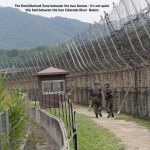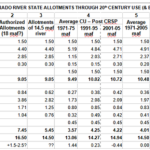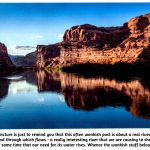I said in the first post here that I’ll be focusing on ‘learning to live with the Anthropocene’ – a work-in-progress for everyone who will even acknowledge the existence of the Anthropocene. To refresh your mind on it – the Anthropocene is a new epoch in the evolution of the planet in which the human species is a factor in shaping the planet’s further evolution. This is an ‘honor’ we did not consciously seek – because who would want that kind of responsibility? But we have backed into it, as it were, like it or not – unconsciously, to be sure, and sometimes irresponsibly – but it’s where we are.
The Anthropocene follows the Holocene Epoch, which would probably only have been a 20,000-30,000-year interval, plus or minus, of warmth and greenness between epochs of Pleistocene glaciation, had we humans not inadvertently intervened with the advent of the Anthropocene. If you are looking for possible good news in the onset of the Anthropocene, that might be it. Most earth scientists presumed that, as the tilt and wobble of the planet progressed through the Milankovitch cycles, the planet would grow colder again and the Big Ice would return, sometime in the next several thousand years, as it has been doing cyclically for the past two million years.
But our conversion of a lot of banked carbon into carbon gases that hold more heat in the atmosphere might forestall that return to a cold planet, with too much of freshwater banked in the solid form that supports no life. A dried-out frozen planet is no more desirable than a dried-out overheated planet. Could it be that two million years dominated by long frozen epochs was an indication that too much carbon had been sequestered from the carbon cycle, which is as foundational to life as we know it as is the water cycle? Has the Pliestocene atmosphere been too devoid of certain gases to retain enough heat, in most phases of the planet’s rotational cycles, to convert snow and ice to the liquid water we need?
So maybe putting some carbon back into the atmosphere was actually a good idea, extending the mellow Holocene. What’s unfortunate is that we didn’t know we were actually doing an interesting experiment like that in bumping up the carbon gases in the atmosphere. Had we been conscious of what we were actually doing in flagrantly burning fossil fuels for work and play – had we also known what we were doing to and for the planet, we might also have figured out when to stop the heating and complete a well-planned and smooth transition to other energy resources. Which is what we are trying to do now, but not smoothly, in a kind of frantic catch-up way, hoping it is not too late….
I think actually knowing what we are doing all the time will be the sine qua non for living in the Anthropocene: no more seat-of-the-pants, hold-my-beer-and-watch-this running off in all directions. It will mean finally growing into the sapient aspect of being Homo sapiens because we don’t have much choice.
Sapiens is a participle of the Latin verb sapere, which basically meant ‘to taste, to know.’ We taste to know; we go everywhere, taste everything, explore everything; try everything, even if it could kill us all – which sometimes it could, like when we dug enthusiastically into the light and dark workings of the atom, or indiscriminately reintroduced massive quantities of sequestered carbon back into the carbon cycle.
Our chronic fault is probably our tendency to act large on little tastes. We learn a little and run with it, creating large works with only partial knowledge of what we are actually doing in terms of consequences. We gradually learn the rest of what we didn’t know when we acted, and sometimes it works out okay; it can be a recipe for great achievements. But other times – it turns into the Greek recipe for classical tragedy, when what we are really learning from big actions based on a little knowledge, is learned too late to help us, and a civilization dies on stage. We’re more often muddling through in the middle regions there – great achievements almost in our grasp, but dragged down by consequences and circumstances we hadn’t anticipated.
Which brings me to the Colorado River: to my mind, the first river of the Anthropocene. A trial run on the Anthropocene, where we as a species go from a million-year Pleistocene ‘natural history’ of adapting to our environments, to a process of consciously adapting our environments to ourselves and our perceived human needs and desires. It’s not that we weren’t already doing this to some extent for the past several thousand years; we just weren’t doing it so obviously and consciously as we began to do it in the Colorado River region, around the turn of the 20th century CE, when we set out to employ the newly developed powers of fossil fuels to change the nature of an often aggressively uncooperative natural river system.
My own conscious involvement with the Colorado River began in 1977 – a very dry year in the whole American West. I was vaguely aware of living in the headwaters of the Gunnison River, which was a tributary of the Colorado River. Beyond that, and what I’d picked up on a tour of Hoover Dam in the early 1960s, I knew very little about the Colorado River. But a magazine that wanted ‘something about the drought in the West’ gave me the opportunity to begin my Colorado River education – writing a long essay about why the drought of 1977 was not a huge problem in the driest quadrant of the West.
In the long history of what we call Western Civilization, 1977 was arguably still at, or just a decade beyond, the apotheosis of the ‘Ascent of Humankind’ mythos I distilled in the last post (click here if you want to look at it again): the story about how we went from being a weak little primate sneaking around the savannas of Africa to becoming the dominant species on the planet.
That was still our dominant mythology in 1977, but we had also just come through a difficult decade in which a number of our great achievements were shown to be haunted by dark doppelgangers of damage to the planet. Tons of our best topsoil were blowing or washing away from rich farmland that had been ‘industrialized’; numerous plant and animal species were disappearing under the onslaught of our expansion into habitats; forests were dying under the acidity of rain falling through air polluted with the gases from burning coal; barrels of industrial waste were rusting away in our ‘out of sight, out of mind’ waste disposal non-policy; our waterways were so polluted with industrial waste that it was hard to make the water potable.
It was a sobering wake-up, but most of the Euro-American nations had responded with a rash of laws, rules and regulations for cleaning up some of the most egregious (and easier) problems (despite unfulfilled warnings from industrial leaders that the clean-up would crash the economy). It was, in fact, possible to incorporate these changes into the story of the ‘Ascent of Humankind’; we were acknowledging responsibilities we had not perceived; we were undiminished – indeed, perhaps elevated – by our acknowledgment of responsibility.
The story of our engagement with the Colorado River was a dramatic sub-story of the ‘Ascent’ mythos – encapsulated in the title of a 1946 Bureau of Reclamation plan for completing the transformation of the river: ‘A Natural Menace Becomes a National Resource.’ And in the dry year of 1977, the Colorado River was the poster child of the ‘Ascent’ mythology. Massive human works had transformed the West’s wildest river into a controlled source of usable water for watering and powering the vigorously growing Southwest, and feeding much of the nation as well. And so much water was stored in reservoirs on the river that – below the reservoirs – the 1977 drought had very little impact.
But at the same time, our recently awakened awareness of unanticipated consequences led us to look with a more critical eye on our own tales of triumph. Yes, we had taught the wild cut-and-run river to stand in and push on our behalf. But – look what was happening: huge cities were springing up in the desert lands of the Southwest, and it was really not that large a river in terms of flow, however powerful its flow might be….
The 1977 Harper’s essay, The Desert Empire,’ was written from that cusp: a celebration of the 1977 achievement in the ‘Ascent’ mode, but with questions about where it all might be going, and whether there would be water enough. Since then, there has been a vast quantity of writing about the Colorado River – dozens of books, hundreds of articles – and nearly all of it has been written at growing distances from that cusp, largely getting into analyses of all the problems that have emerged from our development of the river and its water, with the achievements generally fading into the taken-for-granted background. It is for the most part a chorus of lamentations, requiems for the river, always appropriately illustrated by either a picture of cracked mud or of the Mead Reservoir ‘bathtub rings.’ Or both.
But consider: when I wrote ‘The Desert Empire’ 45 years ago, the river was providing domestic water for around 25 million people; today that number is 40 million people. The amount of land under agricultural irrigation has increased by about a third, to around five million acres. Most of these users are using less water; the great and growing desert cities claim they are delivering no more water in total today than they did in the 1970s despite huge increases in users. That is not something that just happened; there are still achievements to celebrate in the Colorado River Basin, but they are not so exciting as the big structures of the mid-20th century.
Meanwhile, a two-decade ‘drought’ has settled over the Basin, including three years as bad as 1977, leaving average flows for the new century about 20 percent below 20th century averages. Scientists argue, convincingly to me, that at least half of this decline is due to warming of the climate: even if precipitation were to maintain 20th century levels (which it hasn’t consistently), rising temperatures will diminish the river’s water supply because of increased sublimation, evaporation and plant transpiration.
And because the cities will not, cannot stop growing, today’s 40 million domestic users are projected to be 50-60 million by midcentury, all wanting water delivered in civilized systems. We are not yet done developing and distributing the waters of the over-appropriated and over-worked river – but one has to wonder if it can be done in the context of the ‘Ascent of Humankind’ mythos.
Welcome to the Anthropocene. And since the river is such a topic these days, we might take a taste here of its natural history – and why being pushed around a bit is nothing new for it…. In a couple weeks.




I had to find the guy who wrote Desert Empire, and that is how we met. It is a masterpiece.